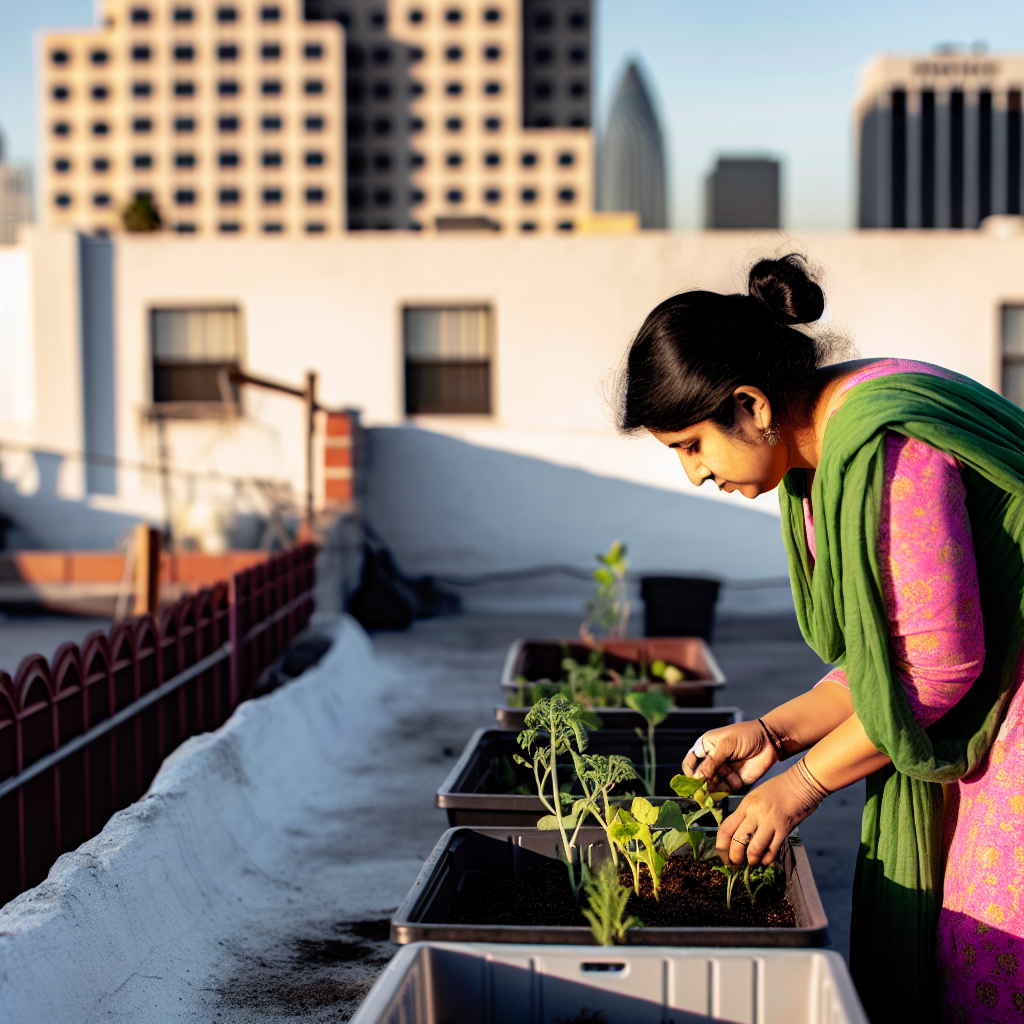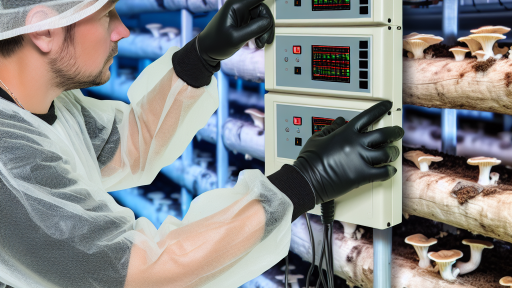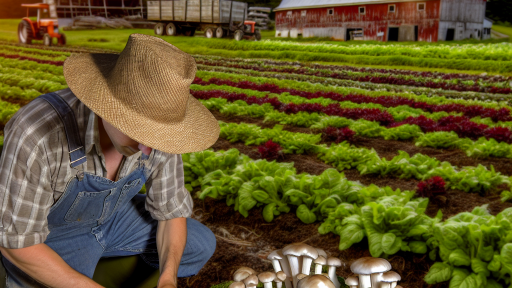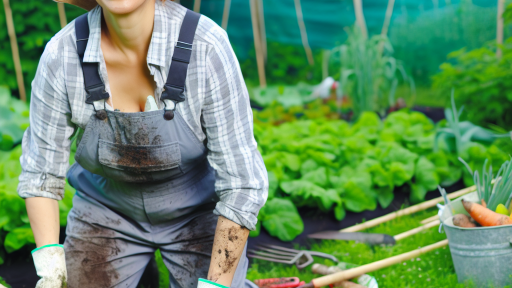Introduction to Container Gardening
Benefits for Urban Farmers
Container gardening offers urban farmers numerous advantages.
First, it maximizes limited space in cities.
Furthermore, it allows for greater mobility in gardening layouts.
Farmers can easily rearrange their containers as needed.
Accessibility and Versatility
Container gardening is accessible to everyone, regardless of skill level.
Beginners can start small and expand as they gain confidence.
Additionally, it accommodates various types of plants and crops.
From vegetables to flowers, the choices are endless.
This flexibility supports diverse gardening interests.
Improved Soil Management
With container gardening, soil quality can be carefully managed.
Farmers can use high-quality potting mixes tailored to their plants.
This helps avoid common soil-borne diseases found in traditional gardens.
Moreover, customizing soil blends can enhance plant health and productivity.
Efficient Resource Use
Container gardening promotes efficient use of water and nutrients.
Farmers can implement targeted watering strategies.
Transform Your Agribusiness
Unlock your farm's potential with expert advice tailored to your needs. Get actionable steps that drive real results.
Get StartedThis reduces waste and conserves resources.
Furthermore, it allows for precise nutrient applications for optimal growth.
Year-Round Gardening
One of the major benefits is the ability to garden year-round.
Farmers can move containers indoors during colder months.
This ensures continued growth and harvests regardless of the season.
As a result, container gardening helps sustain food production throughout the year.
Choosing the Right Containers
Size Considerations
Choosing the correct container size is crucial for plant health.
Smaller plants require less room, so opt for smaller pots.
Larger plant varieties benefit from bigger containers.
Consider the root system’s growth when selecting size.
Ensure the container allows for adequate drainage.
Material Choices
The material of your container impacts plant growth.
Terra cotta provides excellent breathability for roots.
Plastic containers are lightweight and easy to move.
Metal containers can heat up quickly but retain moisture well.
Each material has its benefits and drawbacks.
Design and Aesthetics
The design of your container adds beauty to your space.
Choose a style that complements your overall decor.
Consider color, shape, and texture for visual appeal.
Mix and match different designs for an eclectic look.
Keep practicalities in mind while enhancing aesthetics.
Soil and Fertilization Best Practices for Container Plants
Selecting the Right Soil Mix
Choosing the right soil mix is crucial for container gardening success.
A premium potting mix promotes healthy root growth.
Look for mixes that include peat moss, vermiculite, and perlite.
Showcase Your Farming Business
Publish your professional farming services profile on our blog for a one-time fee of $200 and reach a dedicated audience of farmers and agribusiness owners.
Publish Your ProfileThese ingredients improve drainage and aeration.
Additionally, consider organic options for better plant nutrition.
Understanding Fertilizer Types
Fertilizers fall into two main categories: organic and synthetic.
Organic fertilizers enhance soil fertility naturally.
Examples include compost, worm castings, and bone meal.
Synthetic fertilizers provide quick nutrient absorption.
Choose a balanced formula for optimal growth.
Timing Your Fertilization
Timing impacts the efficacy of your fertilization strategy.
Feed your plants during their active growing season.
This typically occurs in spring and summer.
Use slow-release fertilizers for continuous nutrition.
Alternatively, apply liquid fertilizers every few weeks.
Watering and Nutrient Management
Monitoring moisture levels helps manage nutrient absorption.
Over-watering can leach out essential nutrients.
Check the top layer of soil before watering.
Adjust your fertilization schedule based on rainfall.
Always use pH-balanced water for optimal nutrient uptake.
Signs of Nutrient Deficiency
Recognizing signs of nutrient deficiency is vital for container plants.
Yellowing leaves often indicate nitrogen deficiency.
Additionally, stunted growth can signal a lack of phosphorus.
Monitor your plants regularly for any unusual signs.
Address deficiencies promptly to maintain plant health.
See Related Content: Understanding Seed Germination For Farmers
Selecting Plants for Container Gardening
Optimal Vegetables for Containers
Choosing the right vegetables is crucial for container gardening success.
Consider the size of the container when selecting plants.
Compact varieties thrive in smaller spaces.
Popular options include cherry tomatoes, bell peppers, and radishes.
These vegetables not only bring color but also produce ample yields.
Additionally, leafy greens like spinach and kale grow well in containers.
They require minimal space and can be harvested multiple times.
Furthermore, herbs such as basil, parsley, and chives fit perfectly in small pots.
They add flavor to dishes while taking up little space.
Always check sunlight and watering needs before making a selection.
Optimal Herbs for Containers
Herbs are excellent candidates for container gardening.
They can be grown on balconies, patios, or small yards.
Starting with common herbs is a great idea for beginners.
Popular choices include mint, oregano, and thyme.
These herbs generally require minimal care.
Moreover, herbs like rosemary and cilantro offer distinct flavors.
Consider planting them in separate containers to avoid competing for space.
Showcase Your Farming Business
Publish your professional farming services profile on our blog for a one-time fee of $200 and reach a dedicated audience of farmers and agribusiness owners.
Publish Your ProfileKeep in mind that herbs prefer well-draining soil.
It’s beneficial to fertilize them regularly for optimal growth.
Combining Plants in Containers
Diverse plant combinations can enhance container gardening.
Choose companion plants that benefit each other.
For instance, tomatoes pair well with basil.
This combination discourages pests and improves flavor.
However, avoid planting incompatible species together.
Certain plants can stunt each other’s growth.
Ensure to consider height and sunlight needs when arranging combinations.
Layering plants can create visual interest and enhance space efficiency.
Ultimately, proper planning leads to thriving container gardens.
Gain More Insights: Common Mushroom Farming Challenges and Solutions
Watering Techniques
Importance of Proper Watering
Proper watering techniques are essential for container plants.
These techniques ensure that plants receive adequate moisture.
Moreover, they help prevent both overwatering and underwatering.
Understanding moisture needs enhances plant health and productivity.
Frequency of Watering
The frequency of watering varies depending on plant types.
Succulents and cacti require less water compared to herbs and vegetables.
Always check the soil moisture before watering.
Container gardens might require daily watering in hot weather.
Best Watering Methods
Several efficient watering methods exist for container plants.
Drip irrigation systems deliver water directly to the roots.
This method conserves water and minimizes evaporation.
Another effective method is using self-watering pots.
These pots maintain consistent moisture levels within the soil.
Watering Techniques
Water containers thoroughly to encourage deep root growth.
Avoid shallow watering, as it leads to weak root systems.
Observe the color of the soil; darker soil indicates moisture.
Use rainwater when possible, as it is beneficial for plants.
Additionally, consider the time of day for watering.
Watering early in the morning helps reduce evaporation losses.
Monitoring Soil Moisture
Utilize moisture meters to gauge soil wetness accurately.
These tools provide precise readings of moisture levels.
You can also use your finger; if the top inch feels dry, it’s time to water.
Regular monitoring promotes healthy plant growth and sustainability.
Learn More: Tips For Successful Vegetable Seed Saving

Pest Management and Disease Prevention in Container Gardens
Understanding Common Pests
Garden pests threaten the success of container gardening.
Common pests include aphids, spider mites, and whiteflies.
These pests can damage plants and reduce yields significantly.
Identifying them early is essential for effective management.
Showcase Your Farming Business
Publish your professional farming services profile on our blog for a one-time fee of $200 and reach a dedicated audience of farmers and agribusiness owners.
Publish Your ProfileImplementing Preventative Measures
Prevention is the most effective pest management strategy.
Start by choosing disease-resistant plant varieties.
Healthy plants are less susceptible to infestations.
Also, maintain proper spacing between containers for airflow.
Regular Monitoring
Check your plants regularly for signs of pest damage.
Look for discolored leaves, webbing, or insect presence.
Early detection allows for immediate action.
Neighborhood Ecosystems
Create a balanced ecosystem around your garden.
Encourage beneficial insects such as ladybugs and lacewings.
These insects help control pest populations naturally.
Using Natural Remedies
Natural pest control methods are safe for urban gardens.
Neem oil is effective against many common pests.
Insecticidal soap can also help eliminate aphids and mites.
Employing Physical Barriers
Physical barriers protect plants from pests effectively.
Use row covers to shield young plants from insects.
Mesh nets can deter birds and larger pests.
Preventing Diseases in Container Gardens
Diseases can arise from improper water management.
Avoid overhead watering to reduce fungal infections.
Instead, water the soil directly to minimize leaf wetness.
Soil Health Management
Healthy soil promotes strong plants that resist disease.
Use quality potting soil that drains well.
Consider rotating crops between growing seasons.
Proper Cleanup
Regularly remove dead leaves and debris from the garden.
This minimizes potential breeding grounds for pathogens.
Cleaning containers between crops also helps prevent disease spread.
When to Seek Professional Help
Sometimes, infestations can overwhelm your management efforts.
Consult with local extension services for guidance.
Professionals can provide tailored solutions for your garden.
See Related Content: Sustainable Water Practices in Organic Farming
Seasonal Considerations: Planting and Harvesting Timelines
Understanding Planting Seasons
Each season brings unique opportunities for planting crops in urban environments.
Spring marks the beginning of the planting season for many vegetables.
Consider planting fast-growing crops like radishes and lettuce early in the spring.
Summer is ideal for heat-loving plants such as tomatoes and peppers.
Harvesting Times for Optimal Flavor
Knowing when to harvest is crucial for maximizing flavor and nutrition.
Generally, fruits and vegetables should be picked at their peak maturity.
For instance, tomatoes develop their best taste when fully ripened on the vine.
Additionally, early harvesting can produce tender and flavorful crops.
Seasonal Transition Strategies
As seasons change, adjust your planting schedules accordingly.
Fall planting can include crops like kale and Brussel sprouts, which thrive in cooler temperatures.
Moreover, consider extending your growing season with row covers or cold frames.
Showcase Your Farming Business
Publish your professional farming services profile on our blog for a one-time fee of $200 and reach a dedicated audience of farmers and agribusiness owners.
Publish Your ProfileThis helps protect tender plants from early frosts in fall.
Year-Round Urban Farming Tips
Urban gardeners can enjoy year-round harvesting with proper planning.
Plant hardy varieties that can withstand colder temperatures during winter.
For instance, spinach and garlic can be planted in late fall for spring harvest.
Lastly, utilize indoor spaces for starting seedlings, ensuring a continuous supply of fresh produce.
Creative Space Utilization: Vertical Gardening and Compact Solutions
Making the Most of Small Spaces
Urban environments often limit gardening space.
However, innovative solutions exist to maximize your gardening area.
Vertical gardening is an efficient way to grow plants upward.
This technique uses walls, shelves, or trellises for support.
Compact solutions ensure you can garden even in tiny apartments.
Plants can thrive in pots, hanging baskets, or wall-mounted planters.
Exploring Vertical Gardening Techniques
Vertical gardening offers various methods to utilize vertical space.
First, consider using wall planters for herbs or small flowers.
Next, employ trellises to support climbing plants like cucumbers and beans.
Pallet gardens can transform discarded wood into a vibrant plant display.
Additionally, living walls create stunning visual focal points.
These structures can be installed indoors or outdoors to enhance aesthetics.
Choosing the Right Plants
Selecting appropriate plants is crucial for vertical gardens.
Opt for lightweight varieties that adapt well to limited soil volume.
Herbs like basil, mint, and parsley flourish in vertical spaces.
Additionally, strawberries and cherry tomatoes thrive on trellises.
It’s essential to choose plants suited for your climate and light conditions.
Compact Gardening Solutions
Compact gardening involves growing plants in small areas efficiently.
Raised garden beds can increase growing space in limited backyards.
Portable containers allow for easy relocation based on sunlight needs.
Indoor gardening kits provide all-in-one solutions for aspiring gardeners.
Hydroponic systems enable gardening without traditional soil constraints.
Maintaining Your Garden
Regular maintenance is vital for successful urban gardening.
Ensure proper watering practices to keep plants healthy and hydrated.
Fertilizing every few weeks promotes optimal growth for your plants.
Pay attention to pest control methods, especially in confined spaces.
Finally, regular pruning encourages growth and overall plant health.
Additional Resources
garden design Archives – joe gardener® | Organic Gardening Like a …




